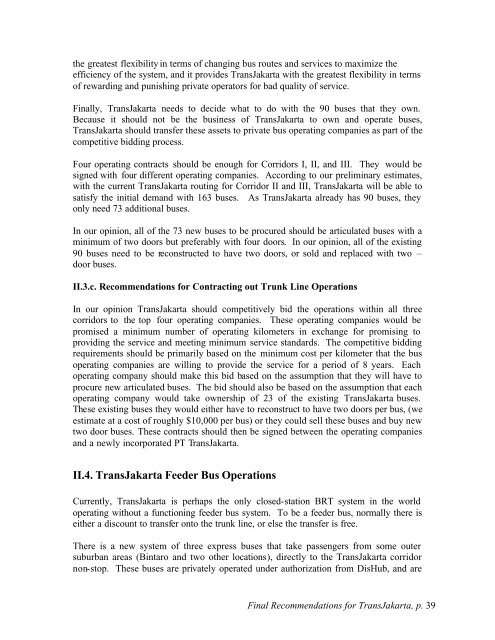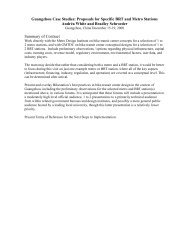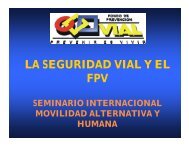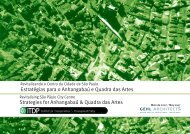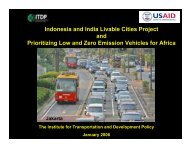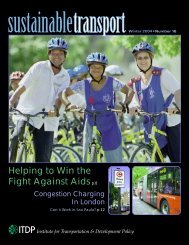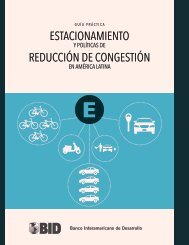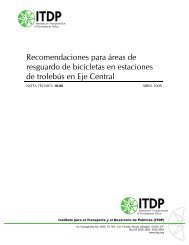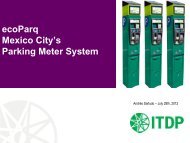Making TransJakarta a World Class BRT System - ITDP | Institute for ...
Making TransJakarta a World Class BRT System - ITDP | Institute for ...
Making TransJakarta a World Class BRT System - ITDP | Institute for ...
You also want an ePaper? Increase the reach of your titles
YUMPU automatically turns print PDFs into web optimized ePapers that Google loves.
the greatest flexibility in terms of changing bus routes and services to maximize the<br />
efficiency of the system, and it provides <strong>TransJakarta</strong> with the greatest flexibility in terms<br />
of rewarding and punishing private operators <strong>for</strong> bad quality of service.<br />
Finally, <strong>TransJakarta</strong> needs to decide what to do with the 90 buses that they own.<br />
Because it should not be the business of <strong>TransJakarta</strong> to own and operate buses,<br />
<strong>TransJakarta</strong> should transfer these assets to private bus operating companies as part of the<br />
competitive bidding process.<br />
Four operating contracts should be enough <strong>for</strong> Corridors I, II, and III. They would be<br />
signed with four different operating companies. According to our preliminary estimates,<br />
with the current <strong>TransJakarta</strong> routing <strong>for</strong> Corridor II and III, <strong>TransJakarta</strong> will be able to<br />
satisfy the initial demand with 163 buses. As <strong>TransJakarta</strong> already has 90 buses, they<br />
only need 73 additional buses.<br />
In our opinion, all of the 73 new buses to be procured should be articulated buses with a<br />
minimum of two doors but preferably with four doors. In our opinion, all of the existing<br />
90 buses need to be reconstructed to have two doors, or sold and replaced with two –<br />
door buses.<br />
II.3.c. Recommendations <strong>for</strong> Contracting out Trunk Line Operations<br />
In our opinion <strong>TransJakarta</strong> should competitively bid the operations within all three<br />
corridors to the top four operating companies. These operating companies would be<br />
promised a minimum number of operating kilometers in exchange <strong>for</strong> promising to<br />
providing the service and meeting minimum service standards. The competitive bidding<br />
requirements should be primarily based on the minimum cost per kilometer that the bus<br />
operating companies are willing to provide the service <strong>for</strong> a period of 8 years. Each<br />
operating company should make this bid based on the assumption that they will have to<br />
procure new articulated buses. The bid should also be based on the assumption that each<br />
operating company would take ownership of 23 of the existing <strong>TransJakarta</strong> buses.<br />
These existing buses they would either have to reconstruct to have two doors per bus, (we<br />
estimate at a cost of roughly $10,000 per bus) or they could sell these buses and buy new<br />
two door buses. These contracts should then be signed between the operating companies<br />
and a newly incorporated PT <strong>TransJakarta</strong>.<br />
II.4. <strong>TransJakarta</strong> Feeder Bus Operations<br />
Currently, <strong>TransJakarta</strong> is perhaps the only closed-station <strong>BRT</strong> system in the world<br />
operating without a functioning feeder bus system. To be a feeder bus, normally there is<br />
either a discount to transfer onto the trunk line, or else the transfer is free.<br />
There is a new system of three express buses that take passengers from some outer<br />
suburban areas (Bintaro and two other locations), directly to the <strong>TransJakarta</strong> corridor<br />
non-stop. These buses are privately operated under authorization from DisHub, and are<br />
Final Recommendations <strong>for</strong> <strong>TransJakarta</strong>, p. 39


